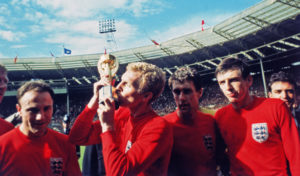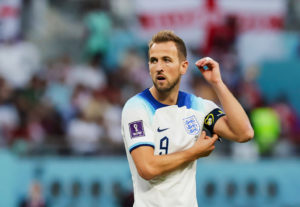Even by the standards of modern football, and even though he has co-owned the club for two and a half years now, there remained something deeply incongruous about seeing Ryan Reynolds applauding Wrexham off after their FA Cup fourth-round tie a week ago. Presenters, used to speaking to the most famous names in football, are visibly starstruck interviewing the star of Deadpool. What is he doing running a fifth-tier side in north Wales? And what does it mean?
Reynolds was brought into the project by Rob McElhenney, co-creator of It’s Always Sunny in Philadelphia. McElhenney, who grew up in Philadelphia, says he saw similarities between Wrexham and his hometown, and was attracted by the story of the club’s struggle to regain Football League status after relegation in 2008. The duo bought the club in September 2020, since when they have invested heavily in players, and are rebuilding a stand at the Racecourse Ground. Attendances have doubled to around 10,000. For years, Wrexham had been battling to survive. One former owner tried to evict them. Even before the FA Cup third round win over Coventry and the draw against Sheffield United (both three divisions above Wrexham), Reynolds and McElhenney were regarded as saviours.
Other clubs may feel resentful of their financial resources, and there was a certain amount of schadenfreude about their defeats in the finals of both the promotion play-offs and the FA Trophy last season. But Reynolds and McElhenney appear to be what they claim to be: two blokes with money who fancied buying a football team. There has been no self-aggrandisement and, as far as possible, a sensitivity to the habits and customs of the British game that has been notably absent from, say, the US billionaire Todd Boehly at Chelsea. They seem genuinely invested in Wrexham, the club and the town, and that they are making a documentary about their experience feels natural enough. They are, after all, film-makers, and the series, Welcome to Wrexham, can only raise the profile of the club — already this season, they’ve sold 24,000 shirts. Yet the presence of Reynolds and McElhenney raises the issue of what a football club is and who its owners should be.
In Britain, where modern football began, clubs were initially societies for enthusiasts, and competitions were then invented to provide structure and significance to their matches. When it became apparent that thousands of people would pay money to watch, the dynamic changed. Liverpool, for example, came into being in 1892 because the owner of Anfield needed a team to play there after Everton relocated to Goodison Park, and Chelsea were founded in 1905 because the owner of Stamford Bridge needed a team to play in his athletics stadium. Even in football’s pioneering early days, finance was never too far in the background. But whether they were founded for love of sport or for monetary gain, football clubs soon took on a symbolic role. They were somehow representative of their town or region, or of a section of society within their area. As Jonathan Meades observed in his 2009 documentary The Football Pools Towns, swathes of places are known almost entirely because of their presence in the Saturday evening litany of classified scores.
Outside the Stadium of Light in Sunderland, built on the crook of the river where the Monkwearmouth Colliery once stood, there is a bronze statue depicting a family dressed in ragged Thirties clothing. Behind two children, a mother holds up the arm of a flat-capped father, face creased by hardship, presumably a miner. “All generations come together at the Stadium of Light,” reads the plaque. “A love of ‘The Lads’ has bonded together supporters for more than 125 years and will for many more years in the future… Supporters who have passed away have their support carried on by today’s fans, just as the supporters of today will have their support continued through family and friends.”
Perhaps it’s trite. Perhaps it’s a skilful piece of emotional manipulation from a club that, in 1997, was desperate to sell the move from Roker Park to sceptical fans. But it seems also profoundly aware of the role football clubs have come to play as repositories for memories of home or family, a means of achieving a continuity with the past, a sense of belonging in a world in which other institutions are breaking down. And in the case of Sunderland and other post-industrial towns, the football club is also a means of memorialising a past in which the city mattered. They may not have won the league since 1936, but Sunderland are the seventh-most successful club in English history because the town used to have mines and shipyards whose owners used their profits to entice the best professionals from Scotland.
All of which is to say two slightly contradictory things. Firstly, that football clubs perform a vital community function, that while they may legally be just like any other business, in reality they represent something rather more precious than that. And secondly, that money has always played its part. When the mine-owner Samuel Tyzack was visiting Scottish grounds disguised as a priest in the 1890s to put together Sunderland’s “Team of all the Talents”, he was different from Ryan Reynolds only in being from the town whose club he funded and in doing the recruitment himself.
It may be that there’s no such thing as the perfect owner, that none of them is entirely pure, running the club to be the best club it can be. They’re probably all in it for some form of gain, be that financial profit or prestige. But since Roman Abramovich bought Chelsea in 2003, there has been a change. There had been fabulously wealthy owners before, people as diverse as Jack Walker at Blackburn Rovers and Brooks Mileson at Gretna, who had taken over the club they supported, invested heavily and achieved a level of success that seemed out of keeping with their fanbase and facilities. But not as fabulously wealthy as the Russian oligarch and not as detached; Walker and Mileson were both fans of the clubs they ended up owning.
The scale of Abramovich’s spending, in an era in which increased global television coverage meant clubs were less reliant on gate receipts, effectively decoupled financial clout in football from on-field success. He had no need to make a profit because that was not his aim; he is estimated to have lost £900,000 a week over his 19 years at Chelsea. What Abramovich actually sought to achieve by buying the club remains unclear, but he was followed by the sportswashing states: Abu Dhabi at Manchester City, Qatar at Paris Saint-Germain and Saudi Arabia at Newcastle. Most Premier League owners — the Glazers at Manchester United, Fenway Sports Group at Liverpool, Stan Kroenke at Arsenal, Boehly and Clearlake Capital at Chelsea — are in it for the money, which inevitably creates tensions with the match-going fans who are more concerned with winning and/or enacting their age-old rituals. Set against that background, Reynolds and McElhenney, with their obvious enthusiasm for Wrexham itself, seem almost a relief. Yet with their documentary about the club, they are part of another trend in modern football, which is the club as producer-of-content.
There have been behind-the-scenes documentaries about clubs before. The early ones, about Leyton Orient and Sunderland in the mid-Nineties, were notable for capturing sweary rants from under-pressure managers. The more recent series Sunderland Til I Die (covering 2017-22) managed to be moving about the fans and their need for the club to be something they could have pride in, while simultaneously portraying a series of directors as vainglorious spoofers. But they were independently made, quite happy to expose such absurdities as an Old Etonian co-owner telling sceptical staff that they should change the running-out music from Prokofiev’s “Dance of the Knights” to something “a bit Ibiza” as everything collapses around him.
The trend has been towards more managed documentaries, such as the Amazon’s All or Nothing series which followed Manchester City, Tottenham and Arsenal. They tend to be bland, concerned with preserving and projecting an image of the club, with little to excite anybody who is not already a fan. The tone of Welcome to Wrexham is different, but it is still club-produced PR rather than journalism. At a much higher level, the director general of Real Madrid, José Ángel Sánchez, and the former CEO of Manchester United, Ed Woodward, have both suggested Disney should be the model. Clubs are no longer reliant for revenues on getting spectators through the gate but must appeal to a global audience in other ways, by providing content for them to consume. That can be short clips on social media — ranging from the mundane, moments in training or visits to fans, to the more inspired, such as Carlos Tevez trying to teach Mario Balotelli how to wrap presents. Or more ambitious products: one major European club has seriously considered an “Entourage-style” fictionalised soap opera set in their club offices.
One level below Wrexham, in National League South, the former England striker Peter Crouch became a director at Dulwich Hamlet in 2021 for a Discovery+ reality show in which he would use his new coaching qualification to “save a failing football club”. That announcement was met with fury by some Hamlet fans, in part because of their objection to his role as a brand ambassador for PaddyPower but also because they didn’t want to become somebody else’s content. Crouch stepped aside last summer, the series apparently discontinued.
It may seem academic, but it matters which came first: is a TV series a useful way to promote the club, or is the club content for a TV series? Might team selections be made to favour more marketable players? Could a season drifting into mid-table irrelevance be given a dramatic boost by signing a controversial and newsworthy striker? Even at the highest level, as anybody who witnessed Woodward’s obsession with social media interactions in his presentations to Manchester United shareholders will know, there can be times when it seems celebrity outweighs footballing considerations.
Again, it should be stressed, McElhenney and Reynolds appear ideal owners. But their presence at Wrexham highlights a tension that runs throughout the game. Football has never just been about the game but this recent Disneyfication rubs uneasily against more Romantic notions of what a club represents to its community. Paradoxically, Reynolds and McElhenney have reawakened that spirit at Wrexham: an official 4,782 fans (and in the event probably many more) will travel to Sheffield United for the replay on Tuesday.
Disclaimer
Some of the posts we share are controversial and we do not necessarily agree with them in the whole extend. Sometimes we agree with the content or part of it but we do not agree with the narration or language. Nevertheless we find them somehow interesting, valuable and/or informative or we share them, because we strongly believe in freedom of speech, free press and journalism. We strongly encourage you to have a critical approach to all the content, do your own research and analysis to build your own opinion.
We would be glad to have your feedback.
Source: UnHerd Read the original article here: https://unherd.com/




